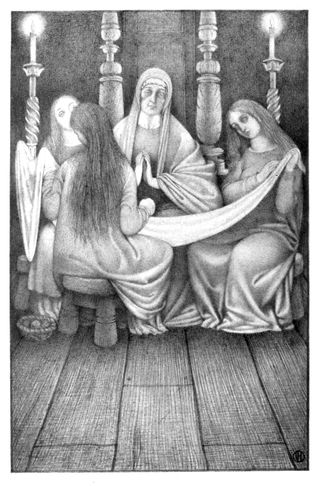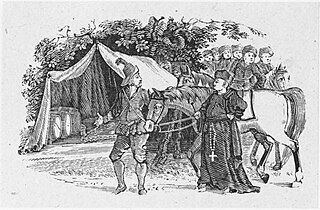Related Research Articles

Robin Hood is a legendary heroic outlaw originally depicted in English folklore and subsequently featured in literature, theatre, and cinema. According to legend, he was a highly skilled archer and swordsman. In some versions of the legend, he is depicted as being of noble birth, and in modern retellings he is sometimes depicted as having fought in the Crusades before returning to England to find his lands taken by the Sheriff. In the oldest known versions, he is instead a member of the yeoman class. Traditionally depicted dressed in Lincoln green, he is said to have stolen from the rich to give to the poor.

The Child Ballads are 305 traditional ballads from England and Scotland, and their American variants, anthologized by Francis James Child during the second half of the 19th century. Their lyrics and Child's studies of them were published as The English and Scottish Popular Ballads. The tunes of most of the ballads were collected and published by Bertrand Harris Bronson in and around the 1960s.
Maid Marian is the heroine of the Robin Hood legend in English folklore, often taken to be his lover. She is not mentioned in the early, medieval versions of the legend, but was the subject of at least two plays by 1600. Her history and circumstances are obscure, but she commanded high respect in Robin’s circle for her courage and independence as well as her beauty and loyalty. For this reason, she is celebrated by feminist commentators as one of the early strong female characters in English literature.
Willie's Lady is Child ballad number 6 and Roud #220. The earliest known copy of the ballad is from a recitation transcribed in 1783.
"The Cruel Mother" is a murder ballad originating in England that has since become popular throughout the wider English-speaking world.

"Lord Thomas and Fair Annet", also known as "Lord Thomas and Fair Eleanor", is an English folk ballad.
Leesome Brand is Child Ballad number 15 and Roud #3301.
The Bent Sae Brown is Child ballad 71.
Willie and Earl Richard's Daughter is Child ballad 102.
Robin Hood's Chase is Child ballad 146 and a sequel to Child ballad 145, "Robin Hood and Queen Katherine". This song has survived as, among other forms, a late seventeenth-century English broadside ballad. It is one of several ballads about the medieval folk hero that form part of the Child Ballads, a comprehensive collection of traditional English and Scottish ballads.
Robin Hood Rescuing Three Squires or Robin Hood and the Widow's Three Sons is a traditional ballad about Robin Hood, listed as Child ballad 140 and Roud 70.

Robin Hood's Death, also known as Robin Hoode his Death, is an Early Modern English ballad of Robin Hood. It dates from at the latest the 17th century, and possibly originating earlier, making it one of the oldest existing tales of Robin Hood. It is a longer version of the last six stanzas of A Gest of Robyn Hode, suggesting that one of the authors was familiar with the other work and made an expansion or summary of the other, or else both were drawing from a lost common tale. The surviving version in the Percy Folio is fragmentary, with sections missing. A more complete but later version is from the middle of the 18th century, and is written in modern English. Both versions were later published by Francis James Child as Child ballad #120 in his influential collection of popular ballads.
Robin Hood and the Tanner is Child ballad 126. It is a late seventeenth-century English broadside ballad and one of several ballads about the medieval folk hero Robin Hood that form part of the Child ballad collection, which is one of the most comprehensive collections of traditional English ballads but has now been subsumed and surpassed by the Roud Folk Song Index.
Robin Hood and the Butcher is a story in the Robin Hood canon which has survived as, among other forms, a late seventeenth-century English broadside ballad, and is one of several ballads about the medieval folk hero that form part of the Child ballad collection, which is one of the most comprehensive collections of traditional English ballads. It may have been derived from the similar Robin Hood and the Potter.

The King's Disguise, and Friendship with Robin Hood is an English ballad of Robin Hood. It is a relatively late work in the corpus, found in the Forresters Manuscript from the 1670s. The work seems loosely based on the 7th and 8th fyttes of A Gest of Robyn Hode which recounts the end of Robin Hood's outlawry after an encounter with the king. Unlike Gest, the king is not acting out of the need to suppress Robin; additionally, The King's Disguise and Friendship uses the 17th century updates to the legend that places Robin as contemporaneous with King Richard's reign. In the late 1800s, Francis James Child included it in his influential collection, the Child Ballads, as #151.
Robin Hood and the Bishop is number 143 in Francis James Child's collection of Child ballads, and describes an adventure of Robin Hood. This song has also survived as a late seventeenth-century English broadside ballad, and is one of several ballads about the medieval folk hero that form part of the Child ballad collection, which is one of the most comprehensive collections of traditional English ballads.
"Robin Hood's Birth, Breeding, Valor, and Marriage" is Child ballad 149. It recounts Robin Hood's adventures hunting and a romance with Clorinda, the queen of the shepherdesses, a heroine who did not prove able to displace Maid Marian as his sweetheart.
Brown Robin is the 97th Child ballad from the collection of 305 ballads from England and Scotland, and their American variants, collected by Francis James Child in the late nineteenth century. The ballad tells the story of a king's daughter who brings her lover, Brown Robin, into the castle and back out without being discovered by the king. The second variant comes from the ballad "Love Robbie."
Erlinton is #8 of the Child Ballads, the collection of 305 ballads from England and Scotland, and their American variants, collected by Francis James Child in the late nineteenth century. The collection was published as The English and Scottish Popular Ballads between 1882 and 1898 by Houghton Mifflin in ten volumes and later reissued in a five volume edition.
"Robin Hood and the Beggar" is a story in the Robin Hood canon which has survived as, among other forms, a late seventeenth-century English broadside ballad, and is a pair out of several ballads about the medieval folk hero that form part of the Child ballad collection, which is one of the most comprehensive collections of traditional English ballads. These two ballads share the same basic plot device in which the English folk hero Robin Hood meets a beggar.
References
- ↑ Francis James Child, English and Scottish Popular Ballads, "Rose the Red and White Lily"
- ↑ "Vaughan Williams Memorial Library - Welcome to the English Folk Dance and Song Society". Vwml.org. Retrieved 2015-06-05.
- 1 2 Francis James Child, The English and Scottish Popular Ballads, volume 2, p 416, Dover Publications, New York, 1965